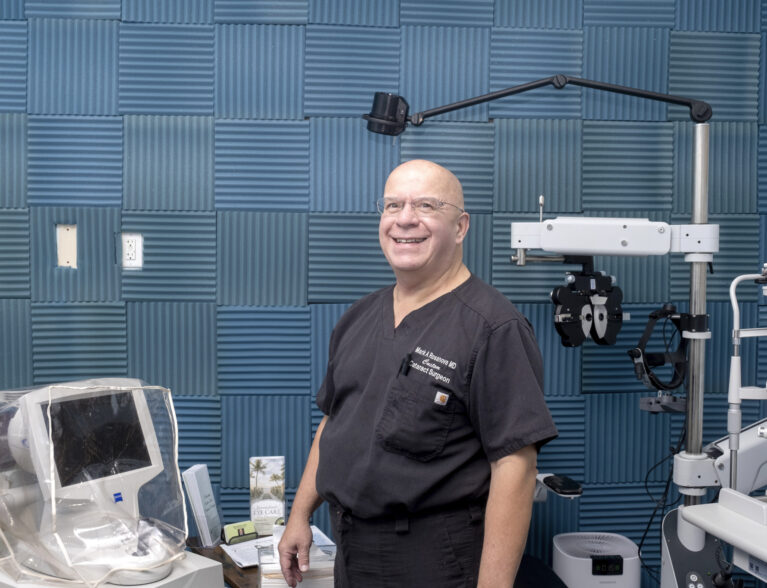
By the age of 75, half of all Americans have cataracts, according to the American Academy of Ophthalmology. And this is not some Johnny-come-lately, lifestyle-driven disease. Cataract surgery has been known to humanity for thousands of years, with the first documented cataract procedure dating back to the fifth century B.C.
Happily, despite its prevalence and longevity, there have been steady advancements in understanding and treating the condition, and cataract surgery is now a highly effective, virtually painless procedure.
Ophthalmologists like Dr. Mark Rosanova use state-of-the-art tools and equipment to bring a level of perfection to the surgery that would have been impossible to imagine 25 years ago, let alone 2,500.
Rosanova, who has had a thriving practice in the Chicago area for decades, opened an office in Brevard County in 2022 because he wanted to introduce cataract surgery that uses LenSx lasers to residents on the Space Coast and Treasure Coast.
LenSx precisely maps the eye using high-resolution images to provide detailed measurements and other data used to perform the surgery. A computer-guided laser makes a tiny incision in the eye, through which the surgeon inserts a small probe. That probe emits ultrasonic energy to break up the damaged lens.
Rosanova says the laser he uses and the method he developed over the past 10 years allows for the safest, quickest and least invasive cataract surgery available. A 3D image of the eye and computer-guided laser treatment allow him to place the implant replacement lens exactly where it needs to go for optimum results. “It’s the same sensation as placing your glasses exactly on your nose where they need to be, allowing you the best-directed vision. Plus, the lens stays in place,” Rosanova says.
Johns Hopkins Hospital describes a cataract as a clouding of the lens of the eye, an area that is normally clear. As this clouding happens, it keeps light rays from passing through the lens and focusing on the retina.
The retina, located in the back of the eye, is a tissue lining that is sensitive to light. This cloudiness happens when some of the protein which makes up the lens of the eye begins to change its structure.
Although age is the major cause of cataracts, the National Eye Institute says that doctors and researchers continue to study why cataracts form. Other factors include:
- Family history of cataracts.
- Diabetes.
- Serious eye injury.
- Eye surgery to treat glaucoma or another eye condition.
- Taking steroids – medicines used to treat some health problems, like arthritis or allergies.
- Radiation treatment for cancer or other diseases.
Things that make cataracts form faster include: - Smoking.
- Drinking too much alcohol.
- Spending too much time in the sun, especially without sunglasses.
Instead of relying on a surgeon to identify where to cut and then use a blade to do so, Rosanova’s bladeless LenSx procedure – which he calls the Rosanova method – provides real-time imaging to the surgeon, making it easier to find the best spots to make incisions. The surgeon then uses the LenSx laser to make precise cuts where needed.
Rosanova adds, “Surgery is IV-free – we use oral sedation only. Almost everyone is a candidate. Other than people who are deaf, have Parkinson’s Disease and similar health issues, and certain types of anxiety concerns, everyone can receive this treatment – regardless of age.”
Mayo Clinic advises that symptoms of cataracts include:
- Clouded, blurred or dim vision.
- Trouble seeing at night.
- Sensitivity to light and glare.
- Need for brighter light for reading and other activities.
- Seeing “halos” around lights.
- Frequent changes in eyeglass or contact lens prescription.
- Fading or yellowing of colors.
- Double vision in one eye.
At first, the cloudiness in vision caused by a cataract may affect only a small part of the eye’s lens and you may not notice any vision loss. As the cataract grows larger, it clouds more of your lens. More clouding tends to cause more noticeable symptoms.
Doctors suggest making an appointment for an eye exam if you notice any changes in your vision. If you develop sudden vision changes, such as double vision or flashes of light, sudden eye pain or a sudden headache, see a doctor immediately.
Rosanova adds, “You’re not going to get rid of your glasses, but it’s a practical, safe, fast and more consistent procedure that brings excellent results.”
Dr. Mark Rosanova graduated from Northwestern University Medical School. He is a diplomate of the American Academy of Ophthalmology and is board-certified by the American Board of Ophthalmology. Rosanova Eye is located at 1478 Highland Ave., Suite A, Melbourne, where the phone number is 321-242-2026. Dr. Rosanova is accepting new patients.



